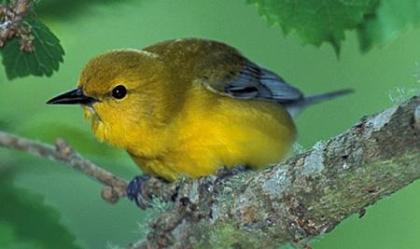Blue-winged Warbler
Vermivora cyanoptera
By Danielle Quick Holmes and Maliyah Faulstich
Appearance
Male Blue-winged Warblers:
According to Birds of North America, adult male Blue-winged Warblers also known as Vermivora cyanoptera have a bright yellow crown, black eye-lines, blueish-gray tails and wings with two white and sometimes yellow wing-bars. They also have a greenish-yellow back and nape. Young Blue-winged Warblers appear rather similar to the adults although they have a less vibrant yellow crown that appears more yellowish-olive. The dull color of the crown results in less of a contrast with the nape and upper parts. Young Blue-winged Warblers have wing bars that are slightly saturated with yellow. In the spring and summer the male bill is black and during the fall and winter their bill is pinkish brown with a dusty black upper bill.
Adult male Blue-winged Warbler

https://birdsna.org/Species-Account/bna/species/buwwar/appearance
Female Blue-winged Warblers:
Adult female Blue-winged Warblers are also similar to males but are duller in overall color. They have more of an olive crown, a grayer eye-line, and less pronounced wing-bars. Young female Warblers are duller than adult females with greenish crowns and no contrast in the nape or upper parts. They also have a distinctive dusty eye-stripe. Females’ bills are similar to males but they are never completely black (Frank, Canterbury, and Confer).
Adult female Blue-winged Warbler

http://nancybirdphotography.com/photographing-a-wave-of-migrating-birds/
All Blue-winged Warbler have blackish brown eyes and a body mass that ranges from 7.2 to 11 g. The Blue-winged Warblers are related to the Golden-winged Warblers. Both male and female adults have grayish-black legs and yellow soles; the young Warblers have dull pinkish gray legs (Frank, Canterbury, and Confer).
Social System
Blue-winged Warblers are rather lonely birds that only interact with their offspring and mates during breeding season. Unlike other birds, Male Blue-winged Warblers follow the alpha male mentality. They not only advertise, but also defend their territory. In addition to this, throughout the past five decades the Blue-winged Warblers have been known to drive out the Golden-winged Warblers throughout the United States. After many experiments it’s been observed that Blue-winged Warblers respond well to not only to playbacks from its conspecifics, but also to audio playbacks produced in the wild.
Blue-winged Warblers are not only lonely birds, but also aggressive birds. Blue-winged Warblers often fight during the first week of arrival in a new territory. In fact, some Blue-winged Warblers have been known to attack Yellow Throated birds, probably due to the false assumption that the Yellow Throated birds were blue or Golden-winged Warblers as well. Territorial boundaries are fortified through interactions with neighboring males. Unmated blue-winged warblers usually torment Gold-winged Warblers upon initial contact. Male blue-winged warblers are aggressive towards their peers during the pre-mating season; however, after they roam the winterlands alone.

http://www.outdooralabama.com/blue-winged-warbler
Breeding Behavior
Nesting Site and Construction:
Male Blue-winged Warblers arrive at the breeding site anywhere between 2 to 9 days before females arrive and wait to pair up. Once the females arrive and they pair with the males they choose the specific nesting site for their young. Some female Warblers start building as early as April 29th in West Virginia. Nests are usually built in the forest by the females about 30 meters outside of the forest edge and in shaded areas. They build their nest on the ground or 30 cm above the ground in bushes or hedges near berry bushes. They usually create their nests during the day in cool and wet weather. Nests take 5 to 12 days to build, but are usually built in 5 days. The nests are often hidden with leaves and other greenery or placed in grass. Their nests are typically 8.7 to 14.5 cm in diameter and 3.3 to 6.2 cm deep. Blue-winged Warblers nests appear similar to Golden-winged Warblers, although, Blue-winged Warblers are often placed slightly higher than than Golden-winged Warblers (Frank, Canterbury, and Confer).
Blue-winged Warbler Nest

https://birdsna.org/Species-Account/bna/species/buwwar/breeding#young
Egg Dates:
According to Birds of North American, in the United States eggs are laid at different times depending on the location the bird is in. However, for the most part eggs are laid between mid May to early June. Incubation starts when the second to last egg is laid and usually lasts 10 to 11 days.
Blue-winged Warbler Eggs

Bustleton, Philadelphia Co., Penn. 27 May.; photographer Rene Corado
https://birdsna.org/Species-Account/bna/species/buwwar/breeding
Habitat of Choice
- During the breeding season they like to nest near herbaceous growth with surrounding forest cover and shrubs. The exact location that the Blue-winged Warbler decides to make its home depends on the density of the shrubbery. The vegetation they like to surround themselves in is near numerous and diverse places from wetlands, to damp and dry areas; however, their habitat is for the most part upland and has an absence of water. Also, unmated blue-wings tend to defend their territory more than mated males in wetter habitats in areas, such as central West Virginia. Blue-winged warblers tend to like tree covering more than herb covering. In the winter blue-winged warblers prefer humid to mildly humid semi-evergreen.
![Image result for blue winged warbler migration]](https://bluewingedwarbler.files.wordpress.com/2017/11/image20result20for20blue20winged20warbler20migration5d5c.jpeg?w=576&h=400)
https://www.sdakotabirds.com/species/blue_winged_warbler_info.htm
Foraging Behavior
Blue-winged Warblers usually eat spiders, beetles, moths, larvae, crickets, and grasshoppers. Foraging occurs towards the upper portion of bushes and trees during breeding season; however, during the colder season they feed fairly closely to the ground and their diet grows to include leaves as well. Also, Blue-winged Warblers will usually eat alone, unless it is mating season; in this case, they will eat near their mate. Blue-winged warblers have a multitude of methods for foraging, ranging from hovering and probing to extracting and hanging upside down. In May probing is a more frequent method of foraging, whereas hanging upside down and gleaning is a more common method in July.

http://www.arkive.org/blue-winged-warbler/vermivora-cyanoptera/
